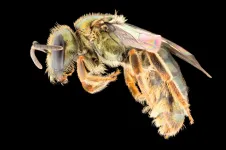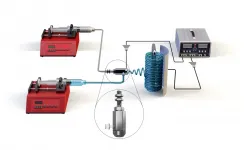(Press-News.org) Researchers from Queen Mary University of London have identified a protein that could be used to aid in the diagnosis of pancreatic cancer.
Findings from the new study suggest that a protein called pentraxin 3 (PTX3) may be a specific diagnostic biomarker - or biological measure - for pancreatic cancer, with the ability to differentiate pancreatic cancer from other non-cancerous conditions of the pancreas.
The research was published today in npj Precision Oncology, and primarily funded by the Pancreatic Cancer Research Fund, Barts Charity and Cancer Research UK.
PTX3 levels elevated in patients with pancreatic cancer
In the study, researchers measured PTX3 levels in serum blood samples from patients with pancreatic ductal adenocarcinoma (PDAC) - the most common type of pancreatic cancer - and from healthy volunteers or patients with other non-cancerous conditions of the pancreas, and found levels of the protein to be significantly higher in the serum samples of those with PDAC.
Patients with PDAC had notably higher serum PTX3 levels than those with intra-ductal papillary mucinous neoplasm or chronic pancreatitis - two non-cancerous conditions that often present with similar symptoms to PDAC, making a definitive diagnosis more difficult.
Hemant Kocher, Professor of Liver and Pancreas surgery at Queen Mary University of London and consultant at Barts Health NHS Trust, who led the study, said: "In the clinic, computerised tomography (CT) scanning is usually used in the diagnosis of pancreatic cancer. Although CT can detect the presence of a pancreatic mass, it cannot distinguish pancreatic cancer from other non-cancerous pancreatic diseases. This poses frequent diagnostic dilemmas in clinical practice, and there are currently no clinically applicable biomarkers for the early detection of PDAC."
"The findings from our study suggest that PTX3 could be used as a biomarker to improve PDAC diagnosis, and warrants further testing to determine whether it could aid early detection of PDAC in the clinic."
"Thanks to the generous donation of samples from patients in London, Verona and Milan, our study represents a clinically relevant cohort with translational significance. This research has been made possible by an international collaboration of cancer biologists, surgeons, oncologists, clinical triallists, statisticians and bio-banking specialists, with funding from a number of sources."
Blood samples from 267 donors were analysed, including 140 samples from patients with PDAC, which had been donated to tissue banks in London, Verona and Milan. Samples in London were from the Pancreatic Cancer Research Fund Tissue Bank - the national tissue bank for pancreatic cancer.
The research was performed in collaboration with researchers from Humanitas Research Hospital and Humanitas University (Milan, Italy), including Dr Paola Allavena and Professor Alberto Mantovani (who also holds the Chair of Inflammation and Therapeutic Innovation at Queen Mary's William Harvey Research Institute), and ARC-NET Research Centre for Applied Research on Cancer (Verona, Italy), including Dr Aldo Scarpa. The Humanitas team is supported by the Italian Association for Cancer Research (AIRC).
A cancer biomarker released from non-cancerous cells
Most cancer biomarkers used in clinical practice are proteins released from the cancer cells themselves. One of the defining features of PDAC is that there are very few cancer cells; pancreatic cancer is surprisingly made up of mostly non-cancer cells, which have been co-opted by cancer to build a huge amount of scar tissue or stroma around the cancer, providing a strong defence for the cancer cells.
The unique feature of PTX3 is that this biomarker is released from non-cancerous cells such as stellate cells (star shaped cells) that surround the pancreatic tumour. Further analyses conducted by the team in human PDAC samples, pancreatic cancer cell lines and a mouse model of pancreatic cancer confirmed that PTX3 is, indeed, released predominantly from pancreatic stellate cells when they have been activated in response to signals from cancer cells.
By looking at data from clinical trials, the team found that when pancreatic cancer alone is targeted, PTX3 does not seem to change upon administration of chemotherapy; however, when medications targeting both cancer and stroma are administered, changes are seen in PTX3 levels. This change in PTX3 can be easily measured in blood to monitor how the drug is working. Thus, PTX3 may help in monitoring the effectiveness of treatment much earlier than scans may be able to indicate treatment response.
Stellate cells have an important role in normal tissue formation, and normal stellate cells do not seem to release PTX3. Stellate cells release PTX3 when they are 'activated,' which can occur in cancer or in response to other conditions. Therefore, further investigations are necessary to determine whether the PTX3 levels detected in this study are specific to stellate cell activation in PDAC.
Direction for future clinical trials
Pancreatic cancer is the deadliest of the common cancers and claims the lives of approximately 9,400 people each year in the UK. The majority of pancreatic cancer cases are diagnosed when the cancer is at an advanced stage due to a lack of specific symptoms at the early stages of the disease and the absence of specific biomarkers that can aid early detection.
This study suggests that PTX3 may be a sensitive and specific biomarker able to distinguish cancerous from non-cancerous conditions of the pancreas. The team hope the findings will provide direction for future prospective clinical trials to determine whether PTX3 could be effective in the clinic as a biomarker for early detection and, perhaps, used in conjunction with other biomarkers to monitor response to treatment of pancreatic cancer.
Maggie Blanks, CEO of Pancreatic Cancer Research Fund, said: "We're extremely pleased that the Pancreatic Cancer Research Fund Tissue Bank has been a valuable resource for this research. It's also exciting to learn that the project has found a new potential biomarker for both earlier detection and treatment monitoring and we look forward to hearing more about the team's progress."
INFORMATION:
This press release is in support of a presentation by Dr Maria Cerrillo Martinez presented online at the 37th Annual Meeting of ESHRE.
29 June 2021: Fertility patients who have a poor response to ovarian stimulation represent a stubborn challenge in IVF. Few eggs are collected, success rates are low, and several treatments are usually needed to achieve pregnancy (if at all). Clinical guidelines indicate that increasing the drug dose for stimulation or applying any of several adjunct therapies are of little benefit. Now, however, a study assessing two cycles of ovarian stimulation and two egg collections in the same menstrual cycle may yet provide ...
This press release is in support of a presentation by Dr Gulam Bahadur presented online at the 37th Annual Meeting of ESHRE.
29 June 2020: Studies indicate that the optimal and safe number of oocytes needed for achieving an ongoing pregnancy is between six and 15. However, the use of egg freezing, frozen embryo replacement (FER) cycles and aggressive stimulation regimes has increased this number in order to boost success rates in older women and in poor responders who produce fewer eggs. What is not known is the impact of numbers of eggs retrieved and of over-stimulation practices on the health of patients, and on their emotional and financial well-being.
Now, a retrospective observational ...
After centuries of human impact on the world's ecosystems, a new study from Flinders University details an example of how a common native bee species has flourished since the very first land clearances by humans on Fiji.
In a new paper in Molecular Ecology (DOI: 10.1111/mec.16034), research led by Flinders University explores a link between the expansion of Homalictus fijiensis, a common bee in the lowlands of Fiji, which has increased its spread on the main island Viti Levu alongside advancing land clearance and the introduction of new plants and weeds to the environment.
"Earlier research connected the relatively recent population expansion to warming climates, ...
What is unique about the study is the combination of interviews with current and former people in prison, custodial professionals, and healthcare providers to identify and understand barriers in delivering high-quality healthcare and support to those in custody. In addition, researchers gathered data on the number, types and stages of cancers diagnosed in patients within prisons.
Moving forward, the researchers believe that findings from this study will help inform prison cancer care policy and develop priorities for improving it within the prison system. The research was funded by the National Institute for Health Research (NIHR), the research partner of the NHS, public health and social ...
Arlington, Va., June 29, 2021 - In the midst of the COVID-19 pandemic, infection preventionists at two Southern California hospitals took extreme measures to stop the spread of a deadly fungus that has emerged in the U.S. and around the world. The two will detail their proactive responses in oral presentations today at the Association for Professionals in Infection Control and Epidemiology's (APIC's), 48th Annual Conference.
In separate responses, Scripps Memorial in La Jolla and UCLA Health in Los Angeles isolated suspected or confirmed patients, worked closely with public health departments and information technology and lab teams at their facilities, and implemented aggressive measures ...
The devastating 2012 - 2016 drought in California triggered widespread tree cover loss and die-offs of a variety of species in the region. A new study in the open access journal Frontiers in Climate is the first to show that California's iconic blue oak (Quercus douglasii) woodlands have also decreased by more than 1,200 km2. By another metric, which reflects the altered or deteriorating condition of the tree cover, the blue oak range has lost over 600 km2 in addition. These findings highlight the need to raise awareness about the vulnerability of these ecosystems and to adapt conservation strategies to increasing climate extremes.
"Our ...
Black men most likely to benefit from advanced prostate cancer therapies are 11 percent less likely to get them than non-Black men. This happens despite apparent equal opportunities in obtaining health care services, a new study in American veterans shows.
Publishing in the journal Cancer online June 29, the study showed that Black male veterans were slightly (5 percent) more likely to receive radiation or surgery for prostate cancer than non-Black men and that veterans of all races likely to benefit from such definitive therapy were also 40 percent more likely to get it compared to those who did not need it.
Led by researchers from NYU Langone Health and Perlmutter Cancer Center, the new analysis showed ...
A new paper in JNCI Cancer Spectrum, published by Oxford University Press, indicates that many survivors of adolescent and young adult cancers hesitate to obtain COVID-19 vaccinations.
As of March 2021, there were over 33 million cases and 580,000 deaths from COVID in the United States. Vaccines offer the best hope to control the spread of COVID-19. Some 20%-40% of the US population, however, is hesitant to obtain COVID-19 vaccination. Cancer survivors often have weakened immune systems and are more likely to develop severe respiratory infections, making them particularly vulnerable to the threat of COVID-19.
National organizations recommend strongly ...
According to the World Health Organization, about 785 million people around the world lack a clean source of drinking water. Despite the vast amount of water on Earth, most of it is seawater and freshwater accounts for only about 2.5% of the total. One of the ways to provide clean drinking water is to desalinate seawater. The Korea Institute of Civil Engineering and Building Technology (KICT) has announced the development of a stable performance electrospun nanofiber membrane to turn seawater into drinking water by membrane distillation process.
Membrane wetting is the most challenging ...
CORVALLIS, Ore. - Research by a graduate student in Oregon State University's College of Science has upended the conventional wisdom that for a century has incorrectly guided the study of a toad listed as endangered in part of its range.
Anne Devan-Song used spotlighting - shining a light in a dark spot and looking for eye reflections - to find large numbers of the eastern spadefoot toad. The study illustrates how confirmation bias - a tendency to interpret new information as ratification of existing theories - can hamper discovery and the development of better ones.
Her findings, which show that the toad spends much more time above ground than commonly believed, were published in the Journal ...


